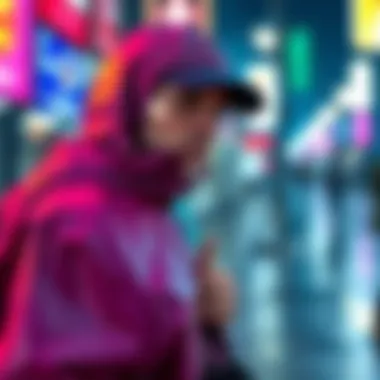Understanding the Importance of Waterproof Wrapping in Fashion


Intro
Waterproof wrapping in clothing has gained traction in recent years, not just as a fashion statement but also as a necessity in today’s unpredictable climate. In the fast-paced world of fashion, the significance of this technique extends beyond aesthetics, offering both protection and durability. Understanding the underlying principles of waterproof wrapping can empower consumers and professionals alike to make prudent decisions regarding their garments.
When one thinks about clothing care, waterproofing often takes a backseat to more prominent concerns like style and fit. However, its absence can lead to unforeseen consequences, from fabric degradation to loss of garment utility. With seasonal shifts bringing rain, snow, and unexpected temperature fluctuations, garments that resist moisture become increasingly relevant.
Why Waterproof Wrapping Matters
Waterproof wrapping serves a dual purpose: it acts as a barrier against moisture while prolonging the life of garments.
- Enhancement of Durability: Fabrics treated with waterproof techniques can withstand the elements, ensuring that investment pieces remain intact through various forms of wear and tear.
- Improved Usability: Wrapped clothing options provide comfort and usability, allowing wearers to navigate daily routines without the worry of sudden weather changes.
For fashion designers and retailers, incorporating waterproof materials into their collections signals a proactive approach to clothing care. This trend hints at a broader vision of sustainability within the fashion industry, encouraging customers to value long-lasting pieces over fast fashion.
"Embracing waterproof wrapping techniques is not merely about trendsetting; it's a commitment to quality and sustainability in fashion."
As we explore the various facets of waterproof wrapping in clothing, it becomes evident that this practice is more than just a protective measure. It stands as a cornerstone in fashion’s journey towards a more informed and sustainable future.
In the subsequent sections, we will delve deeper into specific fashion trends that highlight waterproof wrapping, providing insights on how these elements work harmoniously to craft both functional and fashionable apparel. By pinpointing the latest developments and techniques and addressing environmental implications, we strive to synthesize these elements into a comprehensive guide for fashion designers, stylists, and consumers.
Understanding Waterproof Wrapping
Waterproof wrapping plays a pivotal role in the realm of clothing, especially when considering both functionality and fashion. The simple truth is that nobody wants to be caught out in the rain only to emerge looking like a drowned rat. Therefore, understanding how waterproof wrapping works is not just beneficial for the consumer; it's essential for designers and retailers aiming to produce clothing that meets modern demands for both form and practicality.
This technique not only enhances the durability of garments but it serves as a shield against the elements. When fabrics are treated or wrapped in a manner that repels water, it ensures that clothes maintain their integrity over time, effectively prolonging their lifespan. Furthermore, in a market crowded with options, incorporating waterproof elements can give a competitive edge — a bit like icing on the cake for any brand.
Definition and Purpose
Waterproof wrapping refers to a procedure where clothing materials are enhanced to resist moisture. This can involve a variety of methods, from applying advanced coatings to utilizing specially designed fabrics that inherently possess waterproof qualities. The primary purpose is to keep the wearer dry while simultaneously ensuring the garment itself doesn't become damaged due to moisture.
In practical terms, waterproof wrapping comes into play in various garments, from outerwear like jackets to specialized activewear meant for outdoor activities. Consider a waterproof jacket: its ability to shed raindrops while providing breathability is a game-changer for anyone headed outdoors.
One noteworthy point is that, unlike mere water-resistant materials, waterproof wrapping creates a barrier that prevents water from penetrating the fabric's fibers. Thus, it can stand up to everything from light drizzles to torrential downpours, making it an invaluable feature in some clothing lines.
Historical Overview
The journey of waterproof wrapping is fascinating, tracing back to ancient times when humans first sought to protect themselves from the elements. Initial attempts involved natural materials such as animal skins or treated plant fibers. These rudimentary forms of waterproofing offered basic protection against rain or wet conditions, although they often lacked the sophistication that we see today.
Fast forward to the 19th century, and you have the development of rubberized fabrics. Invented during the Industrial Revolution, these fabrics paved the way for modern waterproof clothing. At that time, companies began to understand the demand for functional yet stylish clothes.
In the 20th century, significant strides were made with the introduction of synthetic materials. Brands like Gore-Tex became household names, revolutionizing the approach to waterproofing by combining comfort with high-performance standards. Today, with advancements in technology, waterproof wrapping can be both efficient and aesthetically pleasing, ensuring that style and utility go hand in hand.
In summary, understanding waterproof wrapping is critical for anyone in the fashion industry. Its evolution reflects how far we’ve come in textile technology, and it showcases the growing importance of marrying practicality with design in modern clothing.
Techniques of Waterproof Wrapping
When it comes to waterproof wrapping, understanding the various techniques involved can vastly enhance the durability and functionality of garments. These methods not only prevent moisture penetration but also contribute to the overall aesthetic and practicality of clothing. Let's delve into the specific techniques that make waterproof wrapping effective and essential in the fashion industry.
Heat-Sealing Methods
Heat-sealing is one of the most common techniques for achieving waterproof seams. It employs heat-sensitive adhesives that bond fabric edges together to create an impermeable seal. This technique can be likened to welding two pieces of metal together, resulting in a joint that’s as strong and secure as the original material. The importance of this method can’t be understated—it's particularly beneficial for outdoor gear, where exposure to the elements is a daily occurrence.
Some key benefits of heat-sealing include:
- Strong Bonding: Once heat is applied, the adhesive fills the gaps in the fabric fibers, creating a robust barrier against water.
- Minimal Bulk: Unlike traditional stitching, heat-sealing maintains a smooth surface, crucial for comfort and style in fashion designs.
- Versatile Application: This method works well on various fabrics, including nylon and polyester, making it adaptable to different garment types.
However, considerations such as the durability of the adhesive at varying temperatures and the potential for breakdown over time must be kept in mind. Choosing heat-sealed garments means investing in quality—look for products that utilize high-grade adhesives to ensure longevity.
Laminate and Coating Applications


The laminate and coating technique involves applying a protective layer onto the fabric surface, effectively repelling water. This method alters the fabric properties to resist moisture without compromising breathability. Think of it as giving your clothes a raincoat; they can repel water while still allowing body moisture to escape, an essential factor for comfort during physical activities.
Common materials used for these applications include polyurethane and polyvinyl chloride, which are known for their waterproof characteristics. Here’s why laminate and coating applications are significant:
- Customization: Designers can tailor the look and feel of fabrics to match specific fashion goals while retaining waterproof qualities.
- Durability: Many coatings are designed to withstand rough conditions, extending the garment's lifespan significantly.
- Sustainability Options: Developing eco-friendly laminates is an emerging trend, providing options that minimize environmental impact.
Nonetheless, it’s crucial to pay attention to how these coatings are applied and their potential to wear off after repeated washes. Regular maintenance and care can extend the efficacy of these waterproof features.
Seam Sealing Techniques
Seam sealing is a vital aspect of waterproof wrapping that ensures even the tiniest gaps in stitching are fortified against moisture. A well-sealed seam can mean the difference between a garment that keeps you dry and one that leaves you soaked through. This technique can involve various methods, including adhesive tape, welded seams, or special seam sealing machines that use a combination of heat and pressure.
Integrating seam sealing into the design process also has distinct advantages:
- Comprehensive Protection: Every inch of the seam receives attention, ensuring complete waterproofing in high-exposure areas like jackets and pants.
- Aesthetics: Seam sealing methods can be visually appealing, often allowing for cleaner lines compared to traditional sewing techniques.
- Adaptability: This technique can be employed alongside other waterproof methods to enhance overall water resistance.
In choosing garments, look for those that not only claim waterproof capabilities but also specify seam sealing as part of their construction. This attention to detail can be a game-changer in how effective a garment is in wet conditions.
In summary, understanding the various techniques of waterproof wrapping—heat-sealing, laminate and coating applications, and seam sealing—is paramount for anyone involved in fashion. These methods not only enhance the functionality of the garments but also resonate with the increasing consumer demand for durable, weather-resistant clothing.
For more information on waterproof fabric techniques, you can visit Wikipedia or Britannica.
By keeping these factors in perspective, fashion designers, retailers, and consumers alike can make informed choices that positively influence garment performance and longevity.
Materials Used in Waterproof Wrapping
The materials utilized in waterproof wrapping are pivotal not just for enhancing garment functionality but also for shaping the future landscape of fashion. Selecting the right materials can markedly influence the effectiveness and longevity of any clothing piece that incorporates waterproof features. This section delves into the various components involved in waterproof wrapping, showcasing their significance and offering insights into notable choices available. By understanding these materials and their characteristics, fashion designers, retailers, and conscious consumers can make informed decisions that align with both performance and aesthetic aspirations.
Fabric Choices
When it comes to fabric choices for waterproof wrapping, the landscape is rich and varied. Polyester and nylon are widely favored for their durability and ability to resist water penetration; however, the sheer number of options has made it crucial to be discerning.
For instance, Gore-Tex, a brand synonymous with water-resistant technology, employs multi-layered constructions that can handle extreme conditions while remaining breathable. Another alternative is eVent fabric, which not only repels water but also prioritizes moisture vapor transfer, which is essential to maintain comfort during physical activities. While these materials are premium choices, they come with their fair share of cost, but the investment often pays off in terms of longevity and reliability.
Nevertheless, it’s vital to consider the kind of clothing being designed. Waxed cotton, for example, offers a unique aesthetic appeal and has historical significance in workwear, while microporous membranes are often seen in high-performance gear meant for outdoor adventures. As you can see, picking the right fabric is not just about water resistance; it's about finding the right balance between protection, breathability, and hardness or softness of touch, depending on the desired garment outcome.
Water Repellent Chemicals
Water repellent chemicals play a critical role in enhancing the performance of fabrics destined for waterproof wrapping. These chemicals often form a hydrophobic layer on the surface of the fabrics, effectively repelling water and allowing moisture to bead up and roll off rather than soaking in. DWR (Durable Water Repellent) is a commonly used finish, providing that crucial first line of defense against precipitation.
It's worth noting, however, that while many companies are moving toward environmentally friendly alternatives, a significant number of DWR treatments still rely on PFCs (perfluorinated compounds), which have garnered criticism for their environmental impact. In response to growing consumer concern, some manufacturers have started utilizing bio-based water repellents, which present a more sustainable option without sacrificing performance.
Fashion brands looking to navigate the myriad options available should consider not just how well these chemicals function but also the lifecycle implications of the finishes applied. Keeping sustainability in sight while considering effective water resistance can set companies apart and lead to better consumer trust.
Sustainable Material Options
In today’s landscape, sustainability is no longer a mere buzzword; it is increasingly becoming a standard to meet consumer expectations. In terms of waterproof wrapping, this means textile producers and fashion labels are challenged to innovate and develop sustainable alternatives.
Materials like recycled PET (rPET), made from post-consumer plastic bottles, are surging in popularity. This resource-efficient approach not only reduces plastic waste but also lowers greenhouse gas emissions in production. Another option is organic cotton, which can be treated to enhance its waterproof capabilities without the use of harsh chemicals. For a luxurious feel, organic cotton can be blended with synthetic fibers that offer waterproof characteristics without compromising the textile's environmental footprint.
Innovations such as biobased polyurethanes and plant-derived materials are gradually entering the market, showcasing an exciting shift towards more sustainable production practices. Embracing these materials reflects a commitment to responsible consumption and serves to resonate with an audience that values ethical fashion.
Understanding the material choices available is key to creating garments that are not only stylish and functional but also conscientious in their environmental impact.
For deeper insights into sustainable clothing practices, visit resources such as Fashion Revolution and Sustainable Apparel Coalition.
As the dialogue around eco-friendly and functionally sound designs grows, staying informed about material innovation becomes essential for anyone involved in the fashion industry.
Applications of Waterproof Wrapping in Fashion


Waterproof wrapping in fashion isn't just about keeping garments dry; it’s about marrying functionality with aesthetics. In our fast-paced world where rapid weather changes can cause unanticipated challenges, understanding the applications of waterproof wrapping can offer numerous advantages to both designers and consumers. This section digs into how these technologies are not just practical but also change the way we perceive style, utility, and sustainability in modern clothing.
Outerwear and Activewear
When it comes to outerwear and activewear, waterproof wrapping serves as the backbone for performance. From sports enthusiasts to urban dwellers, the need for clothing that withstands the elements is paramount.
- Durability and Functionality: The combination of breathable fabrics and waterproof technology allows for maximum movement without sacrificing comfort. Whether it's a downpour during a hiking trip or a light drizzle on a city stroll, wearers can stay dry without overheating thanks to moisture-wicking properties.
- Fashion Meets Utility: Brands like North Face or Patagonia are pioneers in using waterproof wrapping techniques that marry style with durability. This approach appeals not just to athletes but also to fashion-forward individuals who want to showcase trendy, technical outerwear without compromising on functionality.
- Environmental Considerations: Some brands have started using recycled materials in their waterproof clothing, offering a dual benefit of protecting wearers and minimizing environmental impact. This conscientious choice aligns with growing consumer demand for sustainable fashion.
"Incorporating waterproof technology into outdoor apparel isn't just an added feature; it’s what differentiates functional apparel from mere garments."
Fashion Accessories
Accessories often hold the power to either make or break an outfit. With waterproof wrapping, fashion accessories can take on greater versatility.
- Bags and Backpacks: Whether it’s a sleek tote or an active backpack, waterproof materials keep valuables safe from rain or spills. For example, bags from brands like Herschel Supply Co. incorporate such wrapping, allowing for an amalgamation of style and practicality.
- Hats and Gloves: Staying dry doesn't have to mean sacrificing style. Waterproofed hats and gloves not only look chic but insulate against wet weather, catering to those who want to remain fashionable while braving the elements.
- Automated Features: Emerging trends in fashion accessories, such as bags with built-in charging ports or thermal layers with waterproof qualities, show how technology is enhancing traditional designs.
Footwear Enhancements
When it comes to footwear, waterproof wrapping takes on its own distinctive role, providing both protective functionality and stylistic choice.
- Versatility Across Styles: From trendy sneakers to rugged boots, waterproof technology ensures that footwear can be worn in varied environments without being compromised. High-end brands, like Dr. Martens, have introduced waterproof versions of classic designs, allowing for all-weather wear.
- Comfort and Functionality: Waterproof footwear isn't just about staying dry; it also ensures that feet remain comfortable during different activities, whether you're hiking, commuting, or socializing. The integration of breathable, waterproof linings keeps moisture at bay while also providing air circulation.
- Aesthetic Appeal: Footwear design is evolving. More brands are recognizing that waterproof does not mean bulky or unattractive. Sleek designs are emerging that integrate these technologies seamlessly, proving that protection and style can coexist.
Environmental Implications of Waterproof Wrapping
Waterproof wrapping plays a critical role in today's fashion industry, not just for the protection of garments, but also concerning its environmental ramifications. As designers and consumers increasingly recognize the importance of sustainability, it becomes crucial to examine how the fabrics and techniques used in waterproof wrapping affect our planet. Each step in the waterproofing process carries responsibilities that impact ecological balance and, ultimately, the future of fashion.
Impact of Synthetic Materials
One of the most significant concerns with waterproof wrapping involves the synthetic materials often employed in production. Many garments utilize polyester, nylon, or polyurethane because they offer durability and resistance to water. However, these materials come with environmental costs; they shed microplastics during washing, which can find their way into our oceans, adversely affecting marine life and ecosystems. Moreover, the production of synthetic fibers is tied to the reliance on fossil fuels, contributing to greenhouse gas emissions.
Additionally, it’s worth noting that while synthetic materials offer advantages, they aren’t biodegradable. As a result, apparel made solely from these fabrics can take hundreds of years to decompose in landfills, posing ongoing threats to the environment. Fashion brands need to grapple with the contradiction of providing waterproof features while fostering eco-consciousness among consumers.
**"The fashion industry needs to tread lightly; every drop of synthetic fabric can leave lasting footprints."
Recycling Challenges
The journey toward a more sustainable future is fraught with challenges, especially regarding the recycling of waterproof garments. Not all synthetic waterproof materials can be easily recycled, mainly due to the treatments and coatings applied. When clothing is marked with "waterproof" labels, the chemical finishes often complicate the recycling process, making it nearly impossible for facilities to break them down properly.
An additional layer of complexity arises because many consumers are generally unaware of how to dispose of these materials responsibly, often resulting in them ending up in landfills. This ignorance compounds a growing crisis that demands immediate attention.
Brands are pressed to find innovative solutions for recycling their products. Collaborations with recycling companies, investments in research, and the development of circular fashion models can help steer the industry toward more sustainable practices. Building awareness through educational campaigns can empower consumers to make more informed choices.
Innovations in Eco-Friendly Practices
Amid the challenges, several advancements are being made in eco-friendly practices related to waterproof wrapping. The industry is beginning to pivot towards materials derived from renewable resources, such as bio-based plastics or recycled fabrics. For instance, brands are starting to experiment with waterproof treatments that utilize plant-based coatings instead of traditional petrochemicals. Some companies have introduced water-repellent solutions that don’t rely on harmful PFAS (per- and polyfluoroalkyl substances), thereby promoting a cleaner production cycle.
In addition to alternative materials, a push for transparency is emerging within the fashion industry. Consumers are increasingly demanding to know the sourcing and lifecycle of their garments. Brands that make sustainability a priority in their waterproof wrapping techniques can not only gain competitive advantage but also foster loyalty among eco-conscious consumers.
Ultimately, as discussions on sustainable fashion continue to evolve, the significance of waterproof wrapping must shift alongside it. Striking the right balance between performance and responsibility will define the future of clothing—where practicality meets environmental ethics.
Best Practices for Care and Maintenance
Taking care of waterproof wrapped clothing is just as vital as choosing the right pieces in the first place. It’s not enough to have a fashionable outfit that can withstand the elements; proper maintenance ensures that you retain the benefits of waterproofing over time. Neglecting these garments can lead to break down in protective finish and shortened lifespan, so let’s break down the essentials for keeping these items in optimal shape.
Washing and Drying Instructions
When it comes to washing waterproof clothing, caution is key. Most people might think tossing these items into the washing machine on a regular cycle will suffice. However, doing so can compromise the waterproof layers. Here are some essential tips for washing:
- Use a gentle cycle: A delicate or hand wash setting is usually best to avoid wear on sensitive materials.
- Cold water: Hot water can ruin the waterproof coating, so stick to cold.
- Mild detergent: Avoid fabric softeners or bleach, as they can impair the garment's function.


After washing, drying techniques play an equally critical role. Line-drying is a recommended method since heat from a dryer might affect the waterproof layer. If you must use a dryer, choose a low temperature setting and include a dryer ball to help maintain loft without excessive heat exposure.
"The right care can extend the life of your waterproof clothing, keeping you dry and stylish for seasons to come."
Storage Tips
Storing waterproof clothing properly can often be an afterthought, yet it is fundamental for maintaining their functionality. Here’s what you should do:
- Clean before storage: Ensure your clothing is clean and dry to prevent mold or mildew.
- Use breathable storage bags: Sealed plastic bags may sound easy, however they trap moisture. Instead, opt for breathable storage bags or hangers that allow air circulation.
- Avoid hanging too tightly: This prevents distortion of the fabric's shape. If you’re stashing them for a while, gently fold and store them in a dry place.
Considering these storage strategies can save a good piece of clothing from needing early replacement.
Repairing and Refurbishing Techniques
Accidents happen, and in the world of fashion, everything has a lifespan—even your carefully chosen waterproof clothing. Once a tear or breach occurs, it's crucial to act promptly. Here’s how to go about repairs:
- Patch Repairs: For rips or tears, consider using repair patches specifically designed for waterproof fabrics. They can be found at most outdoor or craft stores. Make sure to follow the instructions to get an airtight seal.
- Seam Sealing: If the damage occurs at the seams, it might require more specialized seam sealing tape, which effectively restores waterproof integrity.
- Professional Refurbishing: For more significant damages, don’t hesitate to consult professionals. They can help with reconditioning the waterproof barrier, making your item good as new.
Don't wait until the waterproofing fails entirely; maintaining your garments proactively is always the better route. With these best practices for care and maintenance, you can extend the life of your clothing and ensure they keep performing at their best.
Consumer Awareness and Education
In today’s fashion landscape, where style often runs parallel with substance, consumer awareness and education regarding waterproof wrapping have become paramount. It’s not merely about looking chic in the rain; it’s also about ensuring the garments worn serve their purpose efficiently. With the global push for sustainability combined with consumers demanding transparency from brands, understanding the ins and outs of waterproof techniques can significantly enhance one’s wardrobe. This understanding empowers consumers to make choices that not only benefit them personally but also the environment.
Labeling and Product Transparency
Clarity in labeling is an essential aspect of making informed decisions in the clothing market. When purchasing waterproof items, labels provide crucial information about the methods used and the materials involved. An ideal label should specify whether a garment is treated with a chemical water repellent or utilizes a specific waterproof fabric like Gore-Tex. The more informed a consumer is, the better equipped they are to identify which products will best meet their needs.
Benefits of Transparent Labeling
- Improved Decision-Making: Clear labels allow customers to weigh pros and cons before buying.
- Increased Trust: Brands that are transparent boost customer confidence.
- Sustainability: Knowing whether materials are eco-friendly can help customers support ethical shopping practices.
Often, consumers find themselves in a maze of jargon and misleading terminology. A good education on labels can help them navigate this landscape, ultimately leading to more sustainable consumer choices.
"Awareness is the first step to impactful change. When consumers understand what they’re buying, they drive the demand for better practices in the industry."
Making Informed Purchases
Making informed purchases revolves heavily around understanding the benefits and limitations of waterproof wrapping. When a consumer knows how a specific jacket can withstand downpours while ensuring that the breathability of the fabric is maintained, they’re not just buying for style but also functionality.
Considerations for Informed Purchases
- Evaluate The Use Case: Determine if the garment will be used in heavy rain or sporadic sprinkles.
- Assess the Quality: Higher quality can mean better waterproofing, so don’t shy away from examining the product.
- Price vs. Value: A seemingly more expensive item could last longer and require less replacement.
Future of Waterproof Wrapping in Fashion
The landscape of fashion is evolving rapidly, and so too is the relevance of waterproof wrapping. As our climate shifts and we become more aware of environmental concerns, the significance of waterproof technologies in clothing has never been more pronounced. Incorporating cutting-edge methods of waterproof wrapping not just preserves garments but reflects an evolving standard of consumer expectations. The future, it seems, hinges upon the delicate balance between fashion aesthetics and functional durability.
Trends in Material Innovation
As designers take a closer look at how materials are sourced and processed, innovation in waterproof fabrics is at the forefront. One trend sprouting within this niche is the rise of bio-based materials. Rather than relying solely on traditional plastics, manufacturers are experimenting with options derived from organic sources. For instance, several brands are now utilizing mushroom-based textiles that offer moisture resistance while being fully biodegradable.
Additionally, technical advancements have made it easier to integrate high-performance materials, such as graphene, into everyday fashion. These materials are not only water-resistant but also lightweight and breathable, promoting comfort without sacrificing protection. As fashion goes forward, the challenge remains: can we make these innovations accessible without putting a dent in sustainability efforts?
Furthermore, the adoption of fewer harmful chemicals in water-repellent finishes is gaining traction. Consumers are becoming increasingly conscious of the impact of their choices, signaling a shift towards less toxic methods in garment production.
Consumer Preferences and Expectations
Consumer behavior has seen a notable shift, with an increased demand for versatile and resilient clothing options. Today’s shoppers prioritize durability and functionality without compromising style. This expectation calls for a rethinking of how waterproof wrapped garments are presented in the retail space. Retailers and designers must stay attuned to the evolving consumer psyche, which increasingly favors brands that align with eco-friendly practices.
One noticeable trend in shopping habits is the prevalence of sustainability metrics being factored into purchasing decisions. Shoppers aren't merely asking about price and style anymore; they are inquiring about how garments are made, the longevity of products, and the environmental impact of manufacturing processes. The emergence of certifications like Global Organic Textile Standard (GOTS) or OEKO-TEX adds an extra layer of trust, guiding consumers in making informed purchases.
In essence, the future of waterproof wrapping hinges not only on advances in material science but also on aligning with consumer values. As preferences mature, we are witnessing a landscape where thoughtful craftsmanship and sustainability drive innovation. This confluence of expectations ensures that the industry remains responsive and responsible as it moves forward.
"Fashion can no longer exist in a vacuum; it needs to evolve alongside its environment and the people who wear it."



